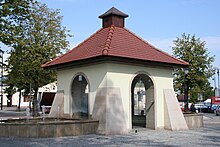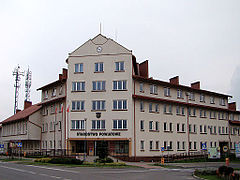|
Kolbuszowa
Kolbuszowa [kɔlbuˈʂɔva] (Yiddish: קאלבאסאוו) is a small town in south-eastern Poland, with 9,190 inhabitants (02.06.2009).[1] Situated in the Sandomierz Forest in the Subcarpathian Voivodship, it is the capital of Kolbuszowa County. Kolbuszowa belongs to historic Lesser Poland, near its border with another historic region, Czerwień Cities/Red Ruthenia. History The name of the town comes from the land owner Kolbusz. It appeared for the first time in 1503 in place where Poręby Wielkie used to exist. The town, which administratively belonged to Sandomierz Voivodeship in the Lesser Poland Province, was probably founded before 1683, when it was mentioned in a trade regulating document of Józef Karol Lubomirski. Kolbuszowa was located on an important trade route from Sandomierz to Przemyśl. As the owners of the area were the Leliwa Tarnowski, Kolbuszowa belonged to Sandomierz County. With regard to the Roman Catholic Church, Kolbuszowa was within the diocese of Kraków, but in 1786 it was moved under the jurisdiction of the diocese of Tarnów. Following the late-18th-century partitions of Poland the town was in the Rzeszów district of the Austrian Galicia and in 1867 it became the seat of its own county (powiat). Before World War II, half of Kolbuszowa's population was Jewish. The coat of arms of the city features a Christian cross and a Star of David with hands shaking between them to symbolize the friendship between Jewish and Christian Poles in Kolbuszowa.[2][3] During the German invasion of Poland at the start of World War II, on September 9, 1939, a 2-day battle[4] between the Polish Army (121st light tank company) and the German 2nd Panzer Division took place here. During the war, German troops burned down part of the town and about half of the Jewish population perished. In September 1941 Germans established a ghetto and interned 2,500 people. In September 1942 the ghetto was emptied and its entire population was moved to a ghetto in Rzeszów. During the war units of Polish Armia Krajowa (AK) and BCh (Polish Peasants' Battalions) operating in this area discovered testing sites for the German V-1 and V-2 rockets in the nearby towns of Blizna/Pustkow. The Red Army entered Kolubuszowa in July 1944 and local Polish AK units (as part of Operation Tempest) attacked retreating German units; several dozen partisans died in the operation. After World War II, Kolbuszowa was rebuilt. New school districts were created, as well as a library and Museum of Culture. In 1964, a new rail link was established: Rzeszów – Głogów Małopolski – Kolbuszowa. In 1971, it was extended to Nowa Dęba and Tarnobrzeg. This connected Kolbuszowa to all the major cities in Poland including the capital, Warsaw. It was a culmination of decades of preparations which started when this part of Poland was under the control of the Austro-Hungarian Empire. In popular cultureThe 2023 Netflix series 1670 was filmed in the open-air Museum of Folk Culture in Kolbuszowa.[5][6] Notable people
International relationsTwin towns — Sister citiesKolbuszowa is twinned with: Gallery
References
|
|||||||||||||||||||||||||||||||||||||||||||||||||
Portal di Ensiklopedia Dunia











